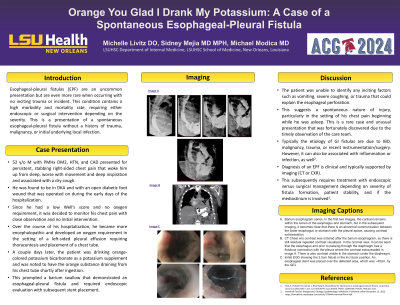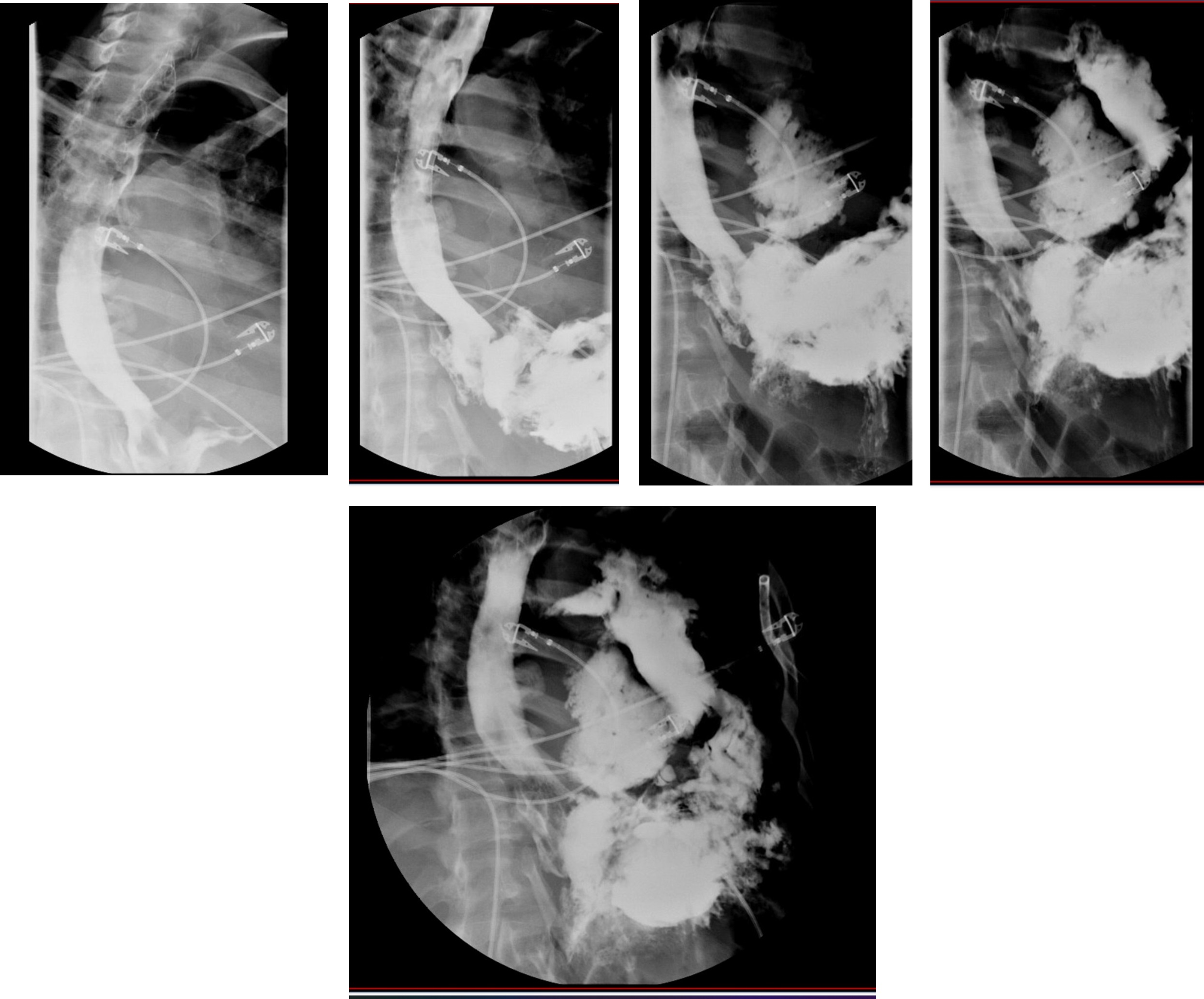Monday Poster Session
Category: Esophagus
P2255 - Orange You Glad I Drank My Potassium: A Case of a Spontaneous Esophageal-Pleural Fistula
Monday, October 28, 2024
10:30 AM - 4:00 PM ET
Location: Exhibit Hall E

Has Audio

Michelle Livitz, DO
Louisiana State University Health
New Orleans, LA
Presenting Author(s)
Michelle Livitz, DO, Sidney Mejia, MD, Michael Modica, MD
Louisiana State University Health, New Orleans, LA
Introduction: Esophageal-pleural fistulas are an uncommon presentation but are even more rare when occurring with no inciting trauma or incident. This condition contains a high morbidity and mortality rate, requiring either endoscopic or surgical intervention depending on the severity. This is a presentation of a spontaneous incident of an esophageal-pleural fistula without a history of trauma, malignancy, or initial underlying local infection.
Case Description/Methods: 52 y/o M with PMHx DM2, HTN, and CAD presented for persistent, stabbing right-sided chest pain that woke him up from sleep, worse with movement and deep inspiration and associated with a dry cough. He was found to be in DKA and with an open diabetic foot wound that was operated on during the early days of the hospitalization. Since he had a low Well’s score and no oxygen requirement, it was decided to monitor his chest pain with close observation and no initial intervention. Over the course of his hospitalization, he became more encephalopathic and developed an oxygen requirement in the setting of a left-sided pleural effusion requiring thoracentesis and placement of a chest tube. A couple days later, the patient was drinking potassium bicarbonate as a potassium supplement and was noted to have the orange-colored substance draining from his chest tube shortly after ingestion. This prompted a barium swallow that demonstrated an esophageal-pleural fistula and required endoscopic evaluation with subsequent stent placement.
Discussion: After the patient returned to his baseline mentation, he was not able to endorse any inciting factors such as vomiting, severe coughing, or trauma that could explain the esophageal perforation. This suggests a spontaneous nature of injury, particularly in the setting of his chest pain beginning while he was asleep. This is a rare case and unusual presentation that was fortunately discovered due to the timely observation of the care team.

Disclosures:
Michelle Livitz, DO, Sidney Mejia, MD, Michael Modica, MD. P2255 - Orange You Glad I Drank My Potassium: A Case of a Spontaneous Esophageal-Pleural Fistula, ACG 2024 Annual Scientific Meeting Abstracts. Philadelphia, PA: American College of Gastroenterology.
Louisiana State University Health, New Orleans, LA
Introduction: Esophageal-pleural fistulas are an uncommon presentation but are even more rare when occurring with no inciting trauma or incident. This condition contains a high morbidity and mortality rate, requiring either endoscopic or surgical intervention depending on the severity. This is a presentation of a spontaneous incident of an esophageal-pleural fistula without a history of trauma, malignancy, or initial underlying local infection.
Case Description/Methods: 52 y/o M with PMHx DM2, HTN, and CAD presented for persistent, stabbing right-sided chest pain that woke him up from sleep, worse with movement and deep inspiration and associated with a dry cough. He was found to be in DKA and with an open diabetic foot wound that was operated on during the early days of the hospitalization. Since he had a low Well’s score and no oxygen requirement, it was decided to monitor his chest pain with close observation and no initial intervention. Over the course of his hospitalization, he became more encephalopathic and developed an oxygen requirement in the setting of a left-sided pleural effusion requiring thoracentesis and placement of a chest tube. A couple days later, the patient was drinking potassium bicarbonate as a potassium supplement and was noted to have the orange-colored substance draining from his chest tube shortly after ingestion. This prompted a barium swallow that demonstrated an esophageal-pleural fistula and required endoscopic evaluation with subsequent stent placement.
Discussion: After the patient returned to his baseline mentation, he was not able to endorse any inciting factors such as vomiting, severe coughing, or trauma that could explain the esophageal perforation. This suggests a spontaneous nature of injury, particularly in the setting of his chest pain beginning while he was asleep. This is a rare case and unusual presentation that was fortunately discovered due to the timely observation of the care team.

Figure: Barium esophagram showing esophageal vs gastric perforation into the left pleura. Later identified to be esophageal in origin on endoscopic evaluation
Disclosures:
Michelle Livitz indicated no relevant financial relationships.
Sidney Mejia indicated no relevant financial relationships.
Michael Modica indicated no relevant financial relationships.
Michelle Livitz, DO, Sidney Mejia, MD, Michael Modica, MD. P2255 - Orange You Glad I Drank My Potassium: A Case of a Spontaneous Esophageal-Pleural Fistula, ACG 2024 Annual Scientific Meeting Abstracts. Philadelphia, PA: American College of Gastroenterology.
